Baldur’s Gate III review:
It’s possible you’ve already played some of Baldur’s Gate 3, with Larian Studios having had their massive fantasy RPG in a successful early access for just under three years. It’s very good. But if you’re one of the many who haven’t, the premise is thus: an ancient evil has, as ancient evil is wont to do, arisen once more to threaten the great walled city of Baldur’s Gate, and by extension the surrounds, and by further extension the world and all the deep gnomes, elves and sexy demon wizards therein. Through happenstance and literal brainworms, you and the band of strange adventurers you meet in the first act are the only ones who can save the day. Don’t worry, you don’t need to remember or have played Baldur’s Gate 1 or 2. So. Off you go, then.
If you’ve played Larian’s previous massive fantasy RPGs, and in particular their pair of Divinity: Original Sin games, or indeed Dungeons & Dragons more generally (whose vaunted TRPG ruleset Baldur’s Gate 3 is officially adapting), you’ll be familiar with the tools you’re given for the business of world-saving. You make a character by picking from different fantastical species (tree elf, rude elf, lizard person, etc) and classes such as monks, druids, and clerics. You’ve got your initiative rolls, your movement speeds, your long and short rests, death saves, and proficiencies. If you’re unfamiliar, then I recommend the lower difficulty setting for your first playthrough, because it still presents a challenge, but it won’t be because you accidentally used all your wizard’s level IV spell slots before a big fight, or because you’re not entirely sure what a spell slot is.
Turn-based combat makes up the majority of what you do in Baldur’s Gate 3, and it can be a fiddly business. Much like building a PC, one wrong move can spaff all your good work up the wall – although there’s usually a way to get yourself out of trouble again, especially if you don’t mind resurrecting a couple of dead team members back at camp. You field a team of four (which should include a tank, a magic user of some kind, and a damage specialist, working around your own character build), and can learn by doing. The doing can take a while, but it is totally fine and proper for some of your experiments to indulge in a bit of save-scumming.
I’d say a practical, directed tutorial might be more helpful for new players. The tooltips, such as they are, provide some measure of help, but combat can be daunting and drawn out, especially in the cases where there are a lot of characters each taking their turn. In some scenarios, for example, you should split up your team and sneak your archer into the rafters before you even speak to any NPCs. Making good use of your ranged DPS characters, using spells that grow spiked vines or spread ice, and sometimes just giving enemies a bloody good shove, all form the weft to the weave of damage dealing. Together, this creates a rich tapestry of taking apart a squad of goblins and splashing blood everywhere. Not realising that throwing and igniting a barrel of oil isn’t just an available option, but one that’s actively encouraged, could make for an unenjoyable early game.
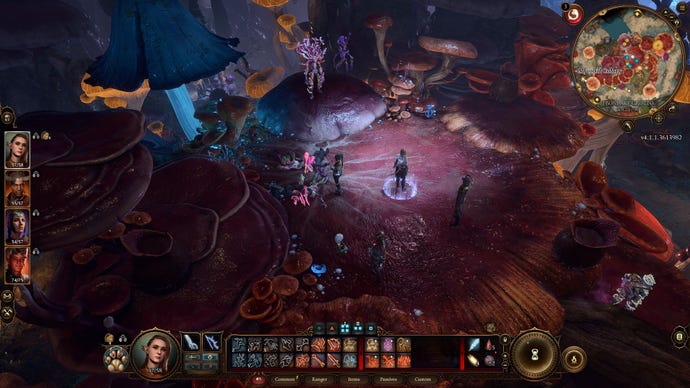
But! Combat, like switching that new PC on and seeing all the parts whirring, is also immensely satisfying. The systems that interlock and interact, from your character stats, to in-world elemental effects, to those gloves you have that let you snatch arrows out of the air, are really good fun once you have a firm grasp of the nettle. Every fight is different thanks to a variety of enemies with their own spells and immunities, but also due to the landscape itself.
And what landscapes. Faerûn may be your typical Eurocentric medieval fantasy land by dint of this being an officially licensed D&D 5th Edition yarn, but across its three acts you’ll see variety in the sprawling maps, with criss-crossing paths and impressive vistas to show off what I think the kids call verticality. Sun-dappled forests, rivers, ruins, a cursed town covered with shadows, a port city, a mythical forge. My favourite is the Underdark, a giant cavern full of gnomes and neon mushrooms that is both beautiful and genuinely otherworldly.
Fully exploring each map will take you a while (I’d estimate about 25 hours per act, give or take) but you are rewarded for your efforts. Though Baldur’s Gate 3 is large, it’s much more focused than other open world adventures where I have complained about them being big for the sake of it. This game doesn’t have a population of endlessly regenerating boars or skeletons for you to XP farm; you won’t find any orphaned goatherd begging you to collect his half a dozen chamois or he will literally die. The number of encounters is fixed and intentional. Diligent exploration rewards the curious with secret cliff paths that you can jump to, and which lead to hidden encounters and back routes into locked areas. You are rewarded, too, for paying attention. Sure, you can kill the witch, but to kill the witch and save the child you might need to recall that you read a recipe for a certain kind of potion earlier in the questline…
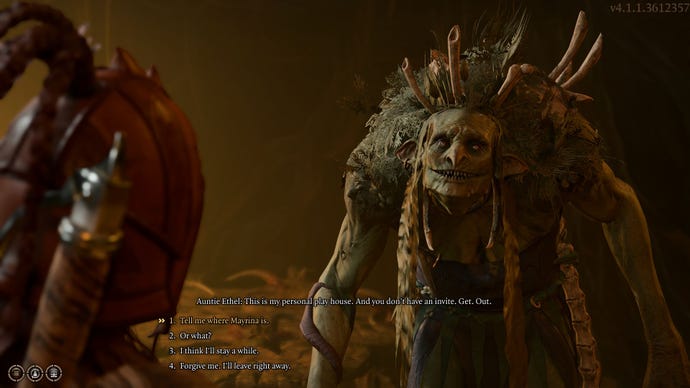
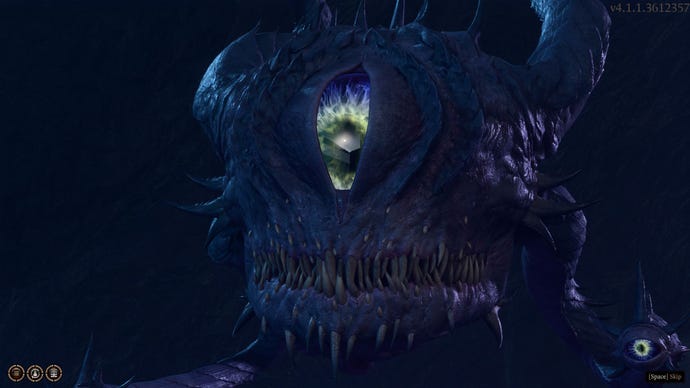
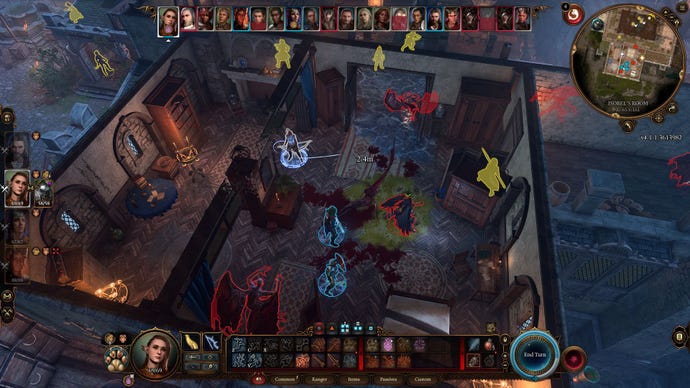
The third act, where you reach Baldur’s Gate itself, contains most of the whimsy you’ll find in the game, but also all the pay-offs for work you did earlier.
The third act, where you reach Baldur’s Gate itself, contains most of the whimsy you’ll find in the game, but also all the pay-offs for work you did earlier. One comparatively small quest saw me hunting down whatever it was that was killing messenger pigeons. This involved a pigeon, who barked at me in the tones of an RAF wing commander, directing me to climb to the roof of the nearby church, where I found a flying cat who loved eating pigeons, and who turned out to be the best friend that wizard companion Gale had mentioned hours ago.
This also breadcrumbed me to a murder mystery taking place inside the church, where a tiny flying elephant was bungling the investigation, and which later turned out to be actually very important. But by then I had my hands full: the girl I saved from a hag in act one was having trouble with her new hag support group; the artist I freed from a gang of smugglers now seemed to be in some sort of possession/haunted house situation; and a guard asked me to take out a gang of gnomes who I had saved from J.K. Simmons’ dungeon in act two. Saving the gnomes had been hard, but they now offered me a quick, easy and explosive solution to a very large problem. If I hadn’t saved them? Their cave would have been empty.
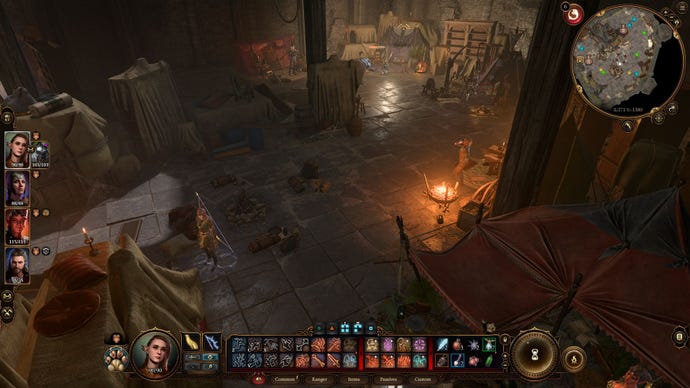
To fully restore yourself after a big fight you need to end the day and go to sleep at camp. Your camp will look different depending where in the world you are, and it’s here you chat to your collection of besties (or frenemies, as the case may be). They’re written to have relatable concerns as well as huge cosmic problems, and the voice actors really bring them alive. And, of course, they are hilariously DTF. Image credit: Rock Paper Shotgun/Larian Studios
In BG3, there’s no baggy excess, but there’s also nothing wasted, whether that be space for a joke in a description of some boots, or the chance to give one entirely optional boss his own song about kicking your ass on the soundtrack – which many players won’t even hear! Rather than feeling like someone has given you a bag of Freddo Frogs to stuff your face and shut your whining, you’ve been presented with a tray of exquisite truffles, made from different types of cocoa bean, hiding centres of caramel or bitter almonds, but each crafted oh so carefully. Baldur’s Gate 3 will give you as much of the range of human emotions it can: you will be delighted, surprised, saddened, frustrated, and even tickled by extreme silliness.
A large part of this is taking chances with your non-combat tests in dialogue, rolling a 20-sided die to succeed at intimidating a nobleman to let refugees stay in his manor and, if not, killing all his mercenaries. The on-screen die makes the game a streamer’s dream, but it can be almost soul-destroying to see a possible option disappear because you, for example, did not persuade a child to talk to you. But that’s the nature of the game, and the failures make your successes actually sweet. And even a success might result in you e.g. getting turned into cheese by a genie.
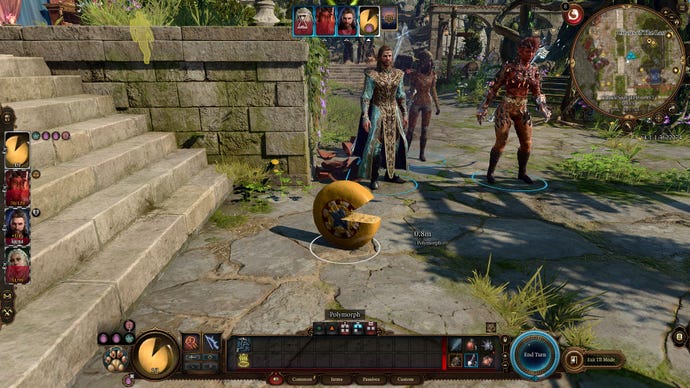
That is, really, how Baldur’s Gate 3 replicates the experience of playing Dungeons & Dragons so accurately. You encounter good and bad luck, and while you can nudge things in your favour, you only really control how you respond to events. The nature of a PC game makes BG3 more limited and less forgiving than a human DM, but the trade off is that, err you can reload and try again if you die. As with the tabletop game, there’s sort of a high barrier to entry built into BG3, and if this isn’t your sort of game then it just isn’t your sort of game. But if it is, then you’ll find all the good things about D&D too. You’re adventuring with a team of people who all have their own stuff going on, you can disarm a trap or you can throw a barrel at it, and you can get to know combat well enough that you can stack damage and take down half a dozen imps in one turn.
And it’s all set against an appropriately world-shaking, god-defying plot with some fantastic writing, and enough characters offer you double-crossings and secret allgiences that you’d suspect Christopher Nolan was involved somewhere. It’s an incredible world to get lost in, and though it may take you 100 hours, you will want to play it again and try new things. It is, in summary, the best Dungeons & Dragons game anyone has made, and probably ever will make – unless there’s a sequel in another 20 years.
Disclosure: Former RPS deputy editor Adam Smith (RPS in peace) now works at Larian and is the lead writer for Baldur’s Gate 3. Former contributor Emily Gera also works on it.
This review is based on both a review build and retail build of the game provided by developers Larian Studios.
window.dispatchEvent(new Event('BrockmanFacebookPixelsEnabled')); }
window.addEventListener('BrockmanTargetingCookiesAllowed', appendFacebookPixels);
[ad_2]